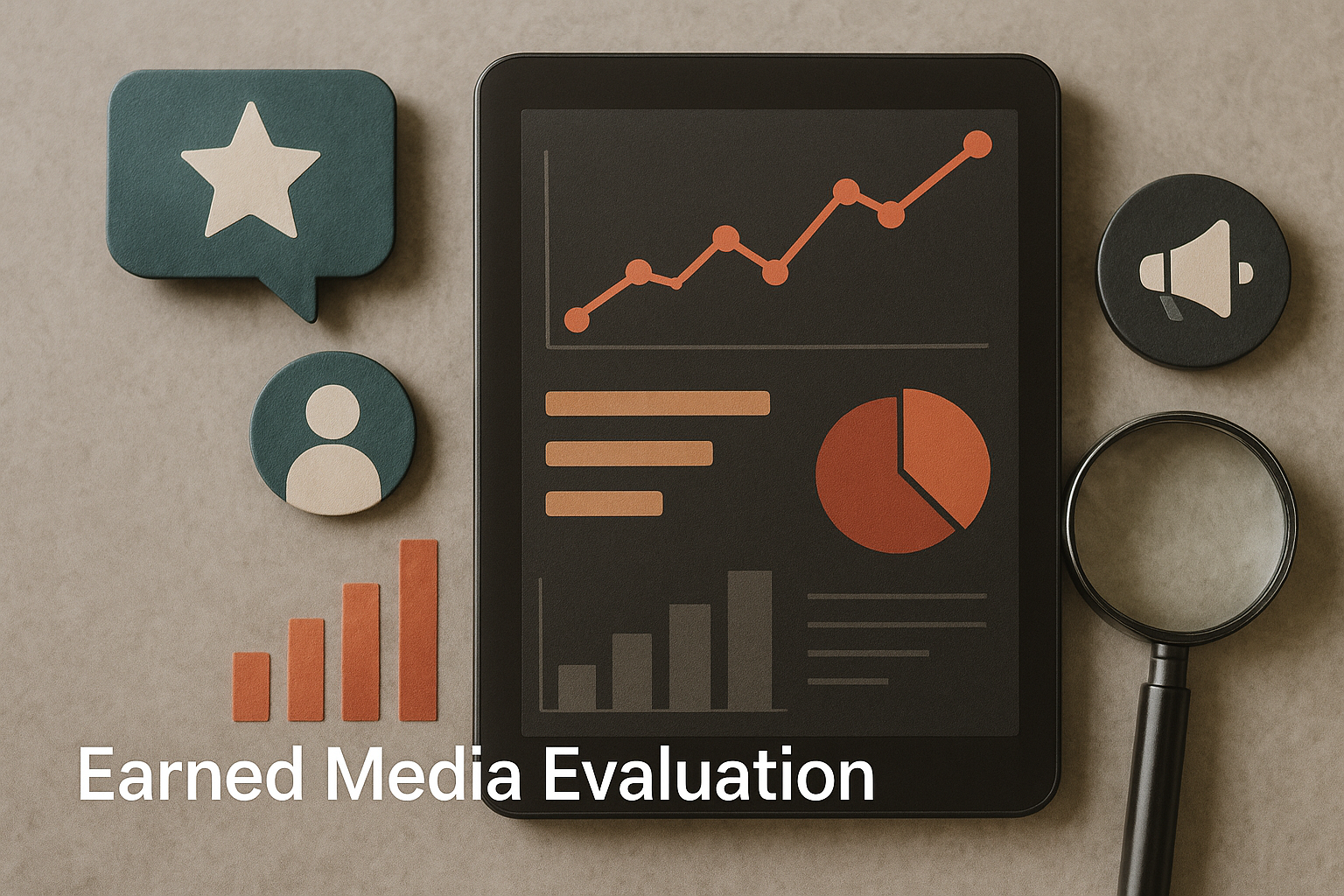Explore how enterprise tech PR builds credibility, manages crises, and adapts to the fast-changing world of enterprise technology.
Big ideas don’t always make the loudest noise. In fact, when it comes to enterprise technology, the stories often hide behind layers of complexity. Cloud platforms, cybersecurity tools, and IT infrastructure may shape entire industries, but explaining that impact isn’t easy. That’s where the PR agency for tech companies come in, with the right kind of storytelling.
Enterprise tech PR takes these technical worlds and turns them into messages people can actually connect with. It’s not about hype, it’s about clarity, trust, and authority. The audience isn’t scrolling consumers; it’s decision-makers, analysts, and business leaders who want solutions that work.
So the challenge becomes simple to state, but tough to master: how do you make complex ideas feel clear, compelling, and credible at the same time? That’s the art and craft of enterprise technology public relations. And in today’s fast-moving market, it’s more essential than ever.
Why Enterprise Tech PR is Different from Consumer Tech PR
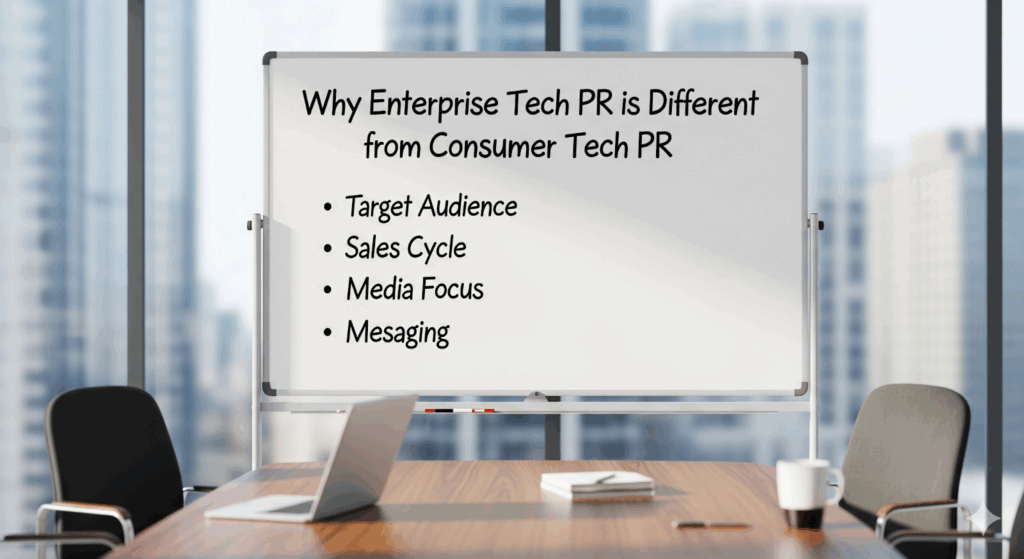
At first glance, PR feels like PR. You pitch stories, chase headlines, and build visibility. But when you compare enterprise tech with consumer tech, the differences quickly show. In B2B technology public relations, the audiences don’t match. The messages don’t land the same. And the way stories travel through the media is an entirely different game.
The Audience Shift
Consumer tech PR often speaks to the masses. Think smartphones, apps, or wearables—products people can see and touch. The goal is excitement. You spark buzz, ride trends, and capture attention fast.
Enterprise tech PR, on the other hand, isn’t chasing clicks. It’s aimed at CIOs, CTOs, and decision-makers with long buying cycles. These readers don’t care about hype. They care about outcomes—security, ROI, integration, and scale. Winning them over takes depth, not just headlines.
The Message Challenge
Consumer stories can shine with lifestyle angles or flashy features. But enterprise IT communications demand clarity above all. Complex products—like data platforms or cybersecurity frameworks—must be explained in plain language.
The trick is turning technical details into real business value. That’s why storytelling here leans on case studies, analyst insights, and thought leadership.
Even the tone changes. Consumer campaigns often celebrate trends. B2B technology public relations campaigns focus on authority, reliability, and trust. A misstep can mean not just lost attention, but lost credibility.
The Media Landscape
Coverage also works differently. Consumer tech stories easily find space in mainstream outlets and lifestyle media. Enterprise technology needs specialized channels—trade publications, analyst reports, and business press. Building relationships here takes patience. Journalists want proof points, not pitches packed with buzzwords.
This is where lessons from other industries, even crypto PR, come in handy. Just like blockchain firms need to build trust before hype, enterprise tech companies must focus on authority before headlines. The right media coverage is about solving problems, not selling promises.
The Stakes
In consumer PR, a failed launch can fade as quickly as it came. In enterprise tech, reputations stick. A single miscommunication can ripple across partnerships, contracts, and long-term deals. That’s why precision, consistency, and credibility matter so much more.
Pulling It Together
So yes, PR is PR in theory. But enterprise and consumer tech live in different worlds. One chases speed and visibility. The other builds trust brick by brick. Both matter, but the playbook isn’t the same. And for companies shaping the backbone of industries, enterprise PR isn’t optional—it’s survival.
Here at Impact Authority, we deal with both kinds. We have PR Specialists for diverse fields, all bringing precise expertise for different PR requirements.
Core Pillars of Enterprise IT Communications

Enterprise tech doesn’t sell itself. It’s complicated, layered, and often buried in jargon. That’s exactly why good communication becomes the backbone. Without it, even the most powerful solution feels invisible. With it, ideas turn into influence. Let’s break down the pillars that hold everything up.
Simplifying Complexity
First things first, clarity. Enterprise IT is packed with acronyms and buzzwords. But buyers don’t want a dictionary; they want answers. Clear, simple language bridges the gap. Think of it as translating code into conversation. If a CIO can explain your solution to their board without stumbling, you’ve done your job.
Building Authority
Trust doesn’t appear overnight. It’s earned piece by piece, through whitepapers, industry reports, and smart commentary. Thought leadership becomes the currency here. When your experts share insights that solve real problems, people listen. Over time, those voices turn into authority, and authority drives reputation.
Creating Trust and Credibility
Numbers help. Case studies, testimonials, analyst endorsements, these are the proof points that reassure buyers. It’s one thing to claim reliability. It’s another to show how a company saved millions, reduced risks, or scaled seamlessly. Just like in crypto PR, credibility beats hype every time. Without it, everything else falls flat.
Staying Consistent Across Channels
A press release says one thing. A blog post says another. A LinkedIn update goes in a different direction. That’s when messaging loses power. Consistency matters. Enterprise IT communications work best when every touchpoint, media, digital, events, echoes the same story. Repetition builds memory, and memory builds trust.
Connecting All the Pillars
Each pillar works alone, but the strength shows when they come together. Clarity opens the door. Authority builds recognition. Trust seals the deal. And consistency keeps the story alive. Miss one piece, and the structure wobbles. Get them all working, and suddenly, enterprise IT messaging feels solid enough to stand on its own.
Crafting Stories That Resonate with Decision-Makers

Selling to a consumer is one thing. Selling to a CIO or CTO is another world. Decision-makers do not get swayed by flashy features or buzzwords. They want proof. They want stories that show real business value. And that is where enterprise storytelling comes into play.
Know Who You Are Talking To
Every story starts with the audience. In consumer tech, the audience may be a teenager buying a new phone. In enterprise tech, it is often a boardroom full of cautious leaders. These people deal with risk, cost, and long-term impact. The language must match. Speak to their priorities. Show them why your solution matters today and why it will still matter years from now.
Focus on Problems, Not Just Products
Decision-makers are not looking for shiny tools. They are looking for solutions to stubborn problems. Security gaps. Rising costs. Scalability issues. A good story highlights the problem first. Then it shows how your product or service solves it in a way that others cannot. This is how you build relevance.
Use Real Examples and Evidence
Abstract promises fall flat. What resonates are real-world results. Case studies, data points, and client wins make a story tangible. For example, instead of saying a system is “faster,” show how it cut processing time by 40 percent. Numbers make stories stick. They also build trust, just like in crypto PR, where credibility is more valuable than hype.
Keep the Narrative Human
Even in enterprise tech, stories are still about people. A cloud platform matters because it makes someone’s work easier. A cybersecurity upgrade matters because it keeps a company safe from a real threat. By putting people at the center, the story feels alive. It stops being about abstract technology and becomes about human impact.
Blend Logic with Emotion
Data-driven arguments speak to the logical side of a decision-maker. But emotion drives urgency. The best enterprise stories combine both. A strong ROI case study shows logic. A story about a company avoiding a damaging data breach adds emotion. Together, they push the audience to act.
Tying It Together
Crafting stories that resonate is not about writing long speeches. It is about clarity, credibility, and connection. Decision-makers remember stories that solve problems, prove value, and highlight people. Get that balance right, and your message will not just be heard. It will be trusted. And in enterprise tech, trust is what opens doors.
Corporate Tech Media Coverage: Breaking Through the Noise

Enterprise technology is not always headline material. It is complex, full of jargon, and often hidden behind the scenes. Yet, without media coverage, even the best solutions risk staying invisible. The challenge is simple to see but hard to solve. How do you make enterprise IT stories stand out in a world already crowded with announcements and buzz?
Understanding the Media Landscape
Consumer tech stories often find quick homes in lifestyle blogs and mainstream outlets. New phones or apps grab attention fast. Enterprise stories, however, need a different stage. Trade publications, analyst reports, and business media become the real battleground. These outlets want insights, not empty claims. They want proof that a product is more than just another tool.
Building Relationships with Journalists
Reporters covering enterprise tech are not looking for hype. They value clear pitches that connect to industry trends, market shifts, or pressing business problems. Building trust with them takes time. Sharing data, customer outcomes, and thought leadership helps create that bond. Just like in crypto PR, credibility matters more than volume. One strong, well-placed story can do more than dozens of shallow mentions.
Crafting the Right Pitch
A good pitch does not start with “we are the best.” It starts with relevance. Is the product solving a problem others are ignoring? Is it saving costs, boosting security, or driving innovation? Framing stories around these angles gives journalists a reason to care. Short, clear language works best. Complexity belongs in the whitepapers, not in the subject line.
The Power of Proof Points
Numbers and real examples bring a pitch to life. For example, showing that a solution reduced downtime by 60 percent is far stronger than claiming “improved performance.” Journalists love stories that can be backed up. These details transform a product announcement into something worth publishing.
Breaking Through the Noise
Noise will always exist. Countless startups and big players fight for attention every day. The difference comes from persistence, clarity, and relationships. Enterprise stories do not need to be flashy. They need to be consistent, trustworthy, and tied to the bigger conversations happening in the industry.
Pulling It Together
Corporate tech media coverage is less about chasing headlines and more about building long-term visibility. The right coverage opens doors, shapes reputation, and builds trust with the people who matter most. When done right, media becomes more than publicity. It becomes proof that an enterprise solution is shaping the future of business.
The Role of Thought Leadership in Enterprise Tech PR
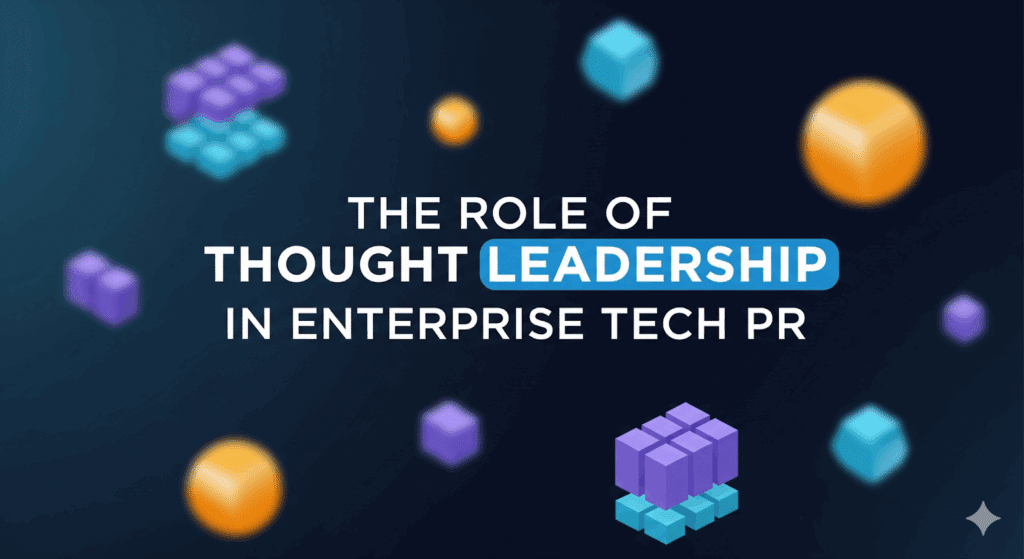
In enterprise technology, trust is everything. Products are complex, investments are large, and buying cycles are long. People do not just buy software or infrastructure. They buy confidence in the people and the vision behind it. This is where thought leadership becomes a powerful tool in Enterprise tech PR.
Executives as Industry Voices
Decision-makers want to hear from other leaders, not just marketing teams. When CIOs, CTOs, or CEOs share insights, it carries weight. Their perspective helps shape conversations in the industry. Whether it is about cloud adoption, cybersecurity, or data-driven growth, leaders become the human face of technology.
Sharing Insights That Matter
Thought leadership is not about self-promotion. It is about offering value. Whitepapers, research reports, or sharp commentary on industry changes can make an executive voice stand out. When content speaks to real challenges, it gets noticed. Over time, consistent insights create authority that no ad campaign can match.
Using the Right Platforms
Not every stage is the same. LinkedIn, for instance, has become a natural hub for professional storytelling. Industry conferences give leaders a live platform to connect with peers. Trade journals and analyst reports amplify credibility even further. By spreading insights across these channels, companies keep their voices active where it matters most.
Blending PR and Content Strategy
Strong thought leadership works best when tied to a bigger communication plan. Articles, interviews, podcasts, and even short videos can extend reach. Each piece should fit into the same story. Consistency builds recognition, and recognition builds trust.
Learning from Other Fields
The approach is similar across industries. Just as finance leaders use commentary to guide markets, or as experts in cybersecurity shape discussions around risk, enterprise tech leaders can use thought leadership to lead debates in their own space. The principle is the same. Authority grows when leaders help others understand change.
Pulling It All Together
Thought leadership is not a side project. It is a pillar of Enterprise tech PR. It turns executives into trusted voices and positions companies as credible players in a crowded market. By sharing knowledge, offering perspective, and speaking with clarity, leaders do more than promote products.
They build lasting influence. And in enterprise technology, influence often shapes the path to growth.
Leveraging Digital PR and Content in Enterprise Technology
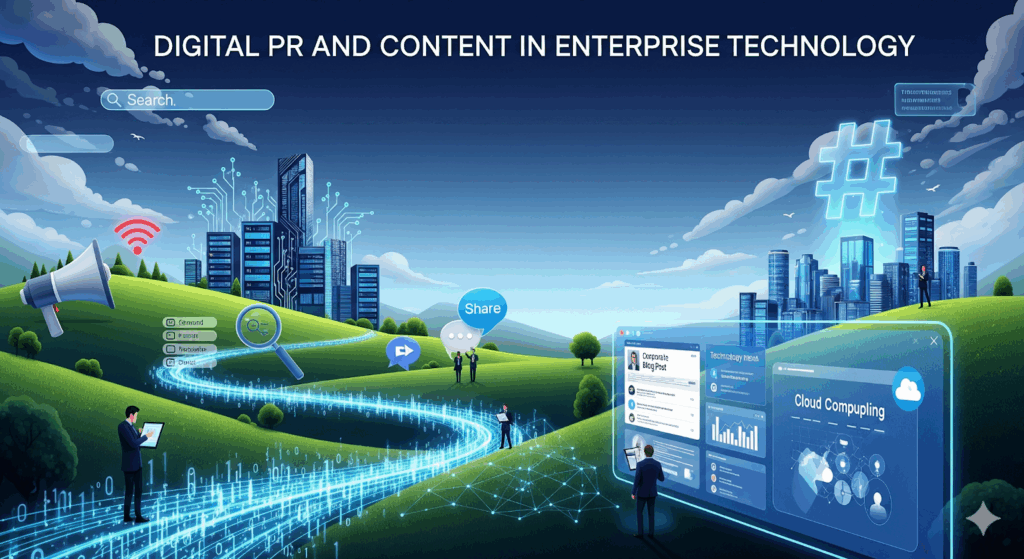
Enterprise technology lives in a world that changes fast. New tools appear, markets shift, and customer needs evolve overnight. Traditional PR still has its place, but digital channels now play an equally important role. Together, they give companies more reach, more control, and more ways to connect.
Blending PR with Content Marketing
Digital PR is not just about press releases on a website. It is about combining storytelling with strategy. Blogs, podcasts, and webinars can extend a company’s message far beyond one article in a trade journal. When paired with classic media coverage, the effect is stronger. In Enterprise tech PR, this blend ensures that complex ideas reach people in multiple ways.
Making Content SEO-Friendly
Content works best when people can find it. That is where SEO comes in. Optimized articles, resource hubs, and whitepapers allow companies to appear in searches when buyers look for answers. The focus should stay on value, not stuffing in keywords. A clear explanation of a problem and a practical solution will always rank better over time.
Using Data as a Story Tool
Numbers tell stories that words cannot. Enterprise technology companies sit on valuable insights that can be turned into digital PR assets. Surveys, research reports, and industry studies provide data that media outlets want to cite. These resources can also fuel blog posts, social updates, and presentations. When data supports the narrative, credibility grows.
Exploring Multimedia Channels
Not every audience learns the same way. Some prefer reading. Others respond better to video explainers, interactive graphics, or live webinars. Podcasts have also become a trusted channel for decision-makers on the go. Mixing these formats keeps the content fresh and makes the story accessible from different angles.
Keeping the Message Consistent
Even with so many channels, the message must remain steady. Whether it is a tweet, a blog post, or a podcast, the core story should stay aligned. Consistency helps audiences connect the dots and recognize the brand voice over time. Without it, content feels scattered, and the impact is lost.
Pulling It Together
Digital PR and content give enterprise technology companies a louder, clearer voice. They extend traditional efforts and make complex stories easier to understand. When done right, they build visibility, trust, and authority. And in the fast-moving world of enterprise tech, that mix is not just useful. It is essential.
Crisis Communications in Enterprise IT
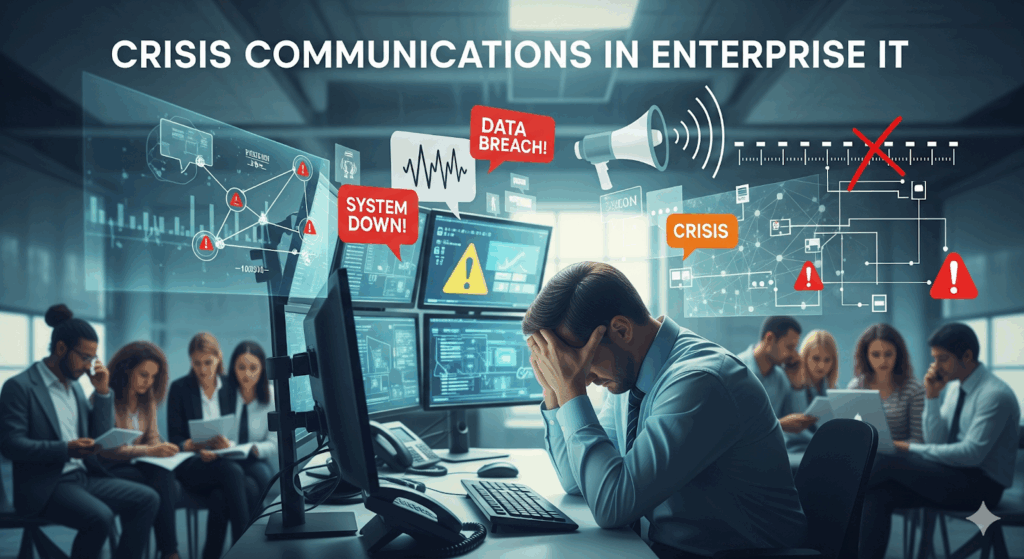
Technology may promise efficiency, but even the best systems can fail. Outages happen. Data breaches strike. Compliance issues surface without warning. In enterprise IT, the stakes are higher because entire businesses rely on these systems to keep running. That is why crisis communications is a core part of Enterprise tech PR. It is not about if a crisis will come, but when.
Preparing Before the Storm
Strong crisis communication starts long before trouble appears. Companies that build clear response plans move faster when problems arise. This means defining who speaks, what channels to use, and how quickly to release information. The more prepared the team is, the less damage a crisis can do.
Acting Fast and Staying Transparent
When an issue surfaces, silence often makes things worse. Decision-makers, customers, and partners want answers right away. Even if all details are not available, a quick and honest statement builds trust. Transparency signals accountability. On the other hand, vague or delayed responses risk damaging credibility for the long term.
Choosing the Right Channels
Not every crisis requires the same response. Some need formal press releases. Others demand direct updates to clients or partners. Social media also plays a role, especially when misinformation spreads quickly. Enterprise IT companies must know which platforms to use and how to adapt the message without losing consistency.
Learning from Mistakes
Every crisis carries lessons. After the immediate issue is resolved, teams should review what worked and what failed in the communication process. This reflection helps refine future responses and strengthens the overall PR strategy. It also shows stakeholders that the company is committed to improving.
Building Back Trust
A crisis may shake confidence, but recovery is possible. Clear communication, combined with visible action, allows companies to rebuild. Over time, consistent updates and proof of improvement turn setbacks into opportunities to show resilience. In fact, some companies emerge stronger because they handled their toughest moments with honesty and care.
Pulling It Together
Crisis communications in enterprise IT is not about avoiding bad press. It is about showing leadership when things go wrong. Preparedness, speed, and transparency make the difference between lasting damage and a chance to prove reliability. For Enterprise tech PR, managing a crisis well can turn risk into an opportunity to strengthen trust.
The Future of Enterprise Tech PR

Enterprise technology never stands still. New tools, new platforms, and new expectations shape the way companies communicate every year. Just like IT itself, Enterprise tech PR must keep evolving to stay relevant. The future will not only be about telling stories but also about connecting them with the right people at the right time.
A Shift Toward Personalization
Audiences no longer respond to broad corporate messages. Decision-makers expect communication that speaks directly to their needs and challenges. PR teams are now using data-driven insights to craft messages that feel more personal and less like a generic pitch. In the future, this shift will become even more important as competition for attention grows.
Technology as a PR Partner
Artificial intelligence, automation tools, and advanced analytics are transforming how PR campaigns are managed. They help track media coverage, analyze sentiment, and predict audience reactions.
While technology cannot replace human creativity, it will continue to support faster and smarter decisions. The companies that balance data with storytelling will lead the next wave of communications.
Building Trust in a Distracted World
Information moves quickly, and misinformation spreads even faster. That is why the role of PR will increasingly focus on trust. Stakeholders want proof, not just promises. Companies that share updates openly, admit mistakes, and highlight real progress will stand out. The future of Enterprise tech PR will belong to organizations that place credibility above short-term wins.
Blending Global and Local Voices
As businesses expand into new markets, PR teams will need to balance global strategies with local relevance. Messages that work in one region may not resonate in another. The ability to adapt communication styles while keeping a consistent brand voice will be a key strength in the years ahead.
Storytelling with Impact
At the core, PR will always be about telling a story. The difference is that future stories will need to cut through digital noise and connect on a human level. Complex IT solutions must be explained in ways that are simple, relatable, and inspiring. That is how enterprise technology brands will win attention and loyalty in the long run.
Looking Ahead
The future of Enterprise tech PR is not fixed. It is a space that will continue to change as technology and expectations shift. What will remain constant is the need for clarity, authenticity, and trust. Companies that embrace innovation while staying true to these principles will shape how the world views enterprise IT in the years to come.
Conclusion
Enterprise tech PR is no longer just about press releases or quick announcements. It is about building trust, shaping stories, and creating connections that last. In a world where technology moves faster than ever, the companies that succeed will be those that adapt, listen, and communicate with honesty.
The future will keep bringing new tools and trends, but the heart of PR will remain the same. Clear storytelling, genuine relationships, and consistent credibility will always matter. When brands approach communication with this mindset, they not only stand out but also lead the conversation.
So as enterprise technology keeps evolving, PR must evolve alongside it. The opportunities are endless, and the possibilities are exciting. What matters most is staying authentic and keeping people at the center of every story.




